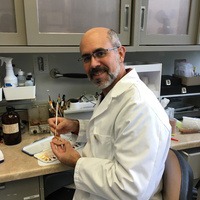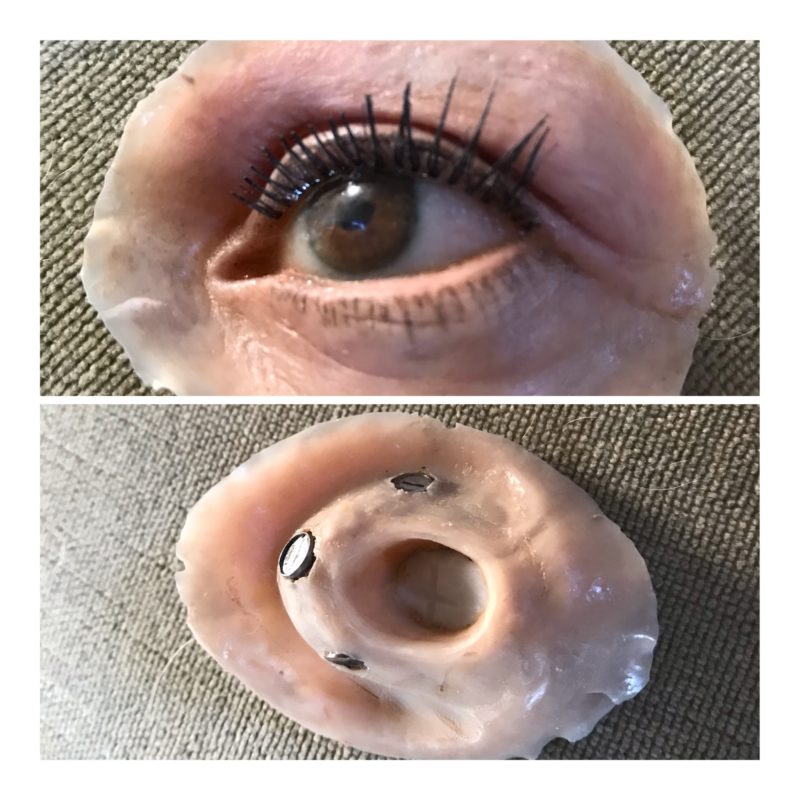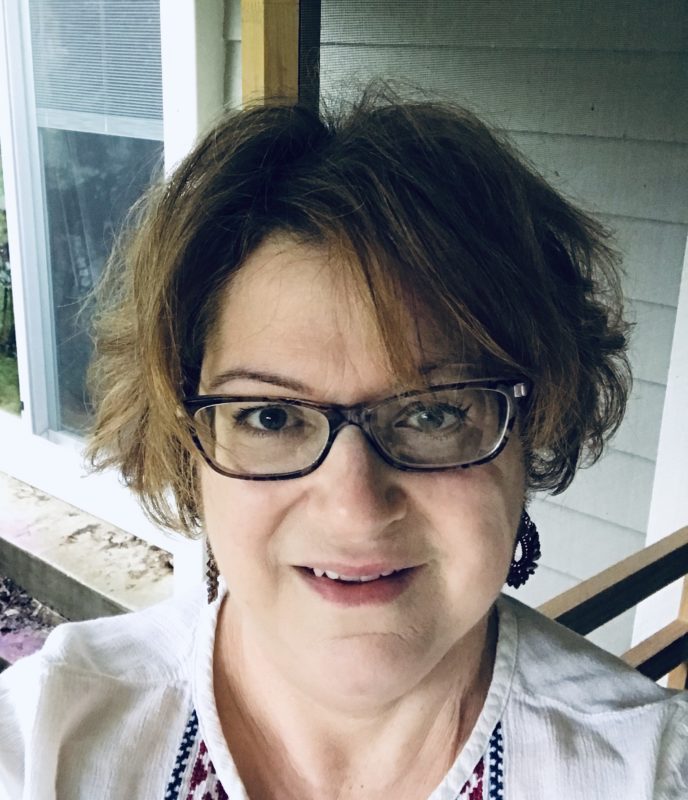Featured Survivor Story:
Suzanne Lescure: One Woman, One Eye, One Extraordinary Survivor


By Vallerie A. Malkin
Suzanne Lescure has always felt lucky. She has a devoted husband. She was able to stay home to raise her two children. The family owned a successful plumbing, heating, and cooling company that afforded flexibility to deal with the unforeseen things that families often encounter.
But then the truly unexpected happened: Lescure was diagnosed with ocular melanoma, a rare form of cancer with a lethal agenda of destruction that would upend and dominate the family’s life for the next decade.
Curious marks, the size of pepper flakes
In 2003, at the age of 43, Lescure discovered a faint cluster of dark specks on the white part of her eye that looked innocuous enough, except that they seemed to come on suddenly.
“They resembled fine, black pepper flakes,” says Lescure, who always had one freckle on the inner corner of her left eye. She noticed the freckle had turned black about the same time as the pepper-like flecks appeared. “Nothing itched or hurt—nobody was concerned.”
The tiny, granular specks were odd, though, and Lescure made an appointment with an ophthalmologist, who suspected they were benign growths. A biopsy was scheduled, and Lescure went about her business.
Two days later, when the lab work came back, Lescure was stunned to learn she had malignant ocular melanoma. In layperson’s terms, that’s cancer on the surface of the eyeball.
A wave of fear splashed over her. “I have kids to raise,” she remembered saying, referring to her son Ryan, born in 1987, and her daughter, Natalie, born in 1991. What if she didn’t make it?
Lescure’s ophthalmologist gave her the names of three ocular oncologists. She chose Dr. Devron Char, in San Francisco, 30 miles from away from Danville, her home at the time. She was overwhelmed with how little information there was on ocular melanoma, but she knew it was a lethal disease.
“There was really no place to reach out to back then,” says Lescure. “I was terrified I couldn’t find evidence that anyone diagnosed with the condition I had was alive.”
Unlucky, but still lucky
Lescure credits her ability to face her diagnosis and ensuing treatments with a strong and supportive family and a good insurance policy. Previously her husband’s employee’s son had had leukemia, and he remembered how the family had struggled financially.
The image stuck with Lescure’s husband, and he had purchased a Cadillac medical plan, which served the family well during what would be a protracted series of grueling medical treatments.
She also had something else going for her: As a stay-at-home mom who did not have to be at a job at 9 a.m. every day, she was able to spend time with her children and focus on what would become the fight of her life.
“I was very lucky to be able to do that,” she says. “I couldn’t imagine how people who worked in an office could work through a serious illness.”
Treatment: Rarely just a straight shot
Lescure had a “super-rare” melanoma subtype called ocular conjunctival melanoma, also known as a “wild type” because it was unclear which mutation she had. Conjunctival melanoma differs from uveal malignant melanoma in that the former travels through the lymphatic system, behaving exactly like skin melanoma. That prognosis had a significant mortality rate attached to it.
Doctors put her on an aggressive program of cryosurgery every three months to freeze the growth, and this went on for three long years. The surgeries were painful. As she made her way to the hospital for treatments, Lescure explains, she would get to the bridge leading to her destination and a feeling of dread would creep in.
“With melanoma, it’s rarely just a straight shot,” explains Lescure, who had to have material extracted from her lower lip to create a buckle membrane graft with dissolvable stitches to restore the damage tissue around her eye.
Doctors decided to add another treatment: proton beam radiation. Lescure had two chemotherapy eye drops thereafter, but that seemed to create more problems than solutions. “My eye started to deteriorate,” she said. “The drops almost melted the surface.”
Eventually, the disease and treatments layered on top of it began to negatively impact her vision. Over time, she began to see light and shadows. Additionally, there was a discharge.
Three years after she was diagnosed, more testing revealed the cancer had metastasized to the submandibular lymph nodes, located under her jaw, pushing her to a Stage III. Doctors ordered a radical neck dissection. During pre-op, the head and neck surgeon discovered she had a spot on her lung. She was now a Stage IV melanoma patient.
Lescure was put on a program of bio chemotherapy that had not at the time been FDA-approved and a high dose of Interleukin-2. She was told the odds were pretty low that she would survive. She spent five days a week every month for six months in a hospital on 24/7 IV drips that pumped the medication into her body. Then she spent three days every month for the next year in the hospital receiving high dose Interleukin-2.
“The treatment was extremely brutal,” says Lescure, without an ounce of self-pity. “I don’t know how I did it, but I was focused.”
Good news and bad news
Her doctors did not tell her, but the treatment had only a five per cent chance of success – dire statistics by any measure. Her husband knew it, but he didn’t want to kill her spirit—he wanted her to fight.
“I’m so glad he didn’t tell me the chances were so low because I may have opted not to do it,” says Lescure. “Thinking about that gives me goosebumps.”
Her melanoma oncologist, Dr. David Minor, suggested she visit Wills Eye Hospital in Philadelphia to talk to the top doctors in ocular melanoma. They were wonderful, she says, but their news was no better. Not only had the pigmentation returned, but it returned in a new, dry place on her eyelid, which meant it was spreading.
She had begun to feel the repercussions of melanoma in terms of her sight. She was exhausted by enduring all of those grueling treatments only to have the disease return each time. She was just 51.
Out, baby, out
Dr. Minor was straightforward with his patient. Lescure recalls him saying, “Since you’ve already gone through Stage IV melanoma, the best thing is to remove the toxic source: the eye and the eyelid.”
Her response to Dr. Minor’s somewhat radical proposal? “I said, ‘Yes, I’m going to do it – I have kids to raise.’”
Says Lescure: “It was almost a relief … and my eye wasn’t that much use.”
Lescure, who by personality bends toward the light, also felt lucky that she had a top-notch doctor and team of nurses and plenty of support from her family.
“Dr. Minor, who has since retired from California Pacific Medical Center in San Francisco, saved my life,” says Lescure. “I have to give equal credit to the nurses for their expertise and compassion.”
“My husband was my supporter and my cheerleader,” she says. “He would do anything and everything. Every time an avenue presented itself, Lescure says her husband would encourage her to try it. He would say, “You’re going to do this – you have no other choice.” His resolve buoyed hers.
She also had a devoted mother-in-law who cooked meals and helped with the children. Sadly, Lescure’s own mother was also going through cancer at the time—small cell lung cancer that had metastasized to her liver.
It was 2011. Lescure had her doctor set up the surgery to remove her eye and lids at Jefferson University Hospital in Philadelphia. That’s where Lescure met Dr. Sara Lally, aka “the eyeball scooper.” (Humor is absolutely necessary when facing dire circumstances, says Lescure.)
An ordeal with a happy ending
Dr. Lally explained everything to her in detail and gave her an anaplastology pamphlet for her to look through – with one eye, of course.
The surgery took 10 hours and was conducted by Dr. Howard Krein, who married Vice President Joe Biden’s daughter, Ashley, in 2012. They met when her brother, Beau, was being treated for brain cancer (Beau Biden died in 2015).
After Lescure’s eye was “scooped out,” the surgeons sewed the vasculature back to her eye using part of her thigh to recreate some of the eyelid tissue so the tissue wouldn’t die. She has a scar from knee to hip. Lescure was asleep during the operation, but she knows they had to take her face off to remove the eye before putting it back on.
She recuperated in Philadelphia for three weeks. Six months later she would face reconstructive surgery, taking tissue that is healed and making it concave to accommodate a prosthetic eye and lids. For a time she endured titanium rods sticking out of the ocular orbit while everything healed.
The process was not quick—the family flew to an organization called Art as Applied to Medicine in Baltimore to be fitted for her ocular prosthetic that would be designed by the anaplastologist, Juan Garcia. She sat like an artist’s model all day long, four to five different times.

Juan R. Garcia, MA, CCA, Associate Professor Since 1999, Mr. Garcia has been the Director of the Facial Prosthetics Clinic practice at John Hopkins University School of Medicine. The clinic provides custom-made prosthetic devices for those with missing facial, ocular and somatic anatomy.
“I love the result,” says Lescure, “Juan Garcia is an artist. He makes you look how you used to look.” The prosthetic is made out of hard acrylic resin. For the skin part of the eyelid, the material used was silicone.

Fast forward to melanoma survivor!
Today, Lescure says she has been given a second chance and there’s only one thing to do: “Pay it forward!” She has enjoyed 12 years with clear scans since the eye replacement.
“It’s been an incredible journey,” says Lescure, giddily.

Suzanne Lescure, Ocular Melanoma Survivor
As part of her paying it forward, Lescure speaks to nurses’ panels and is a member of a survivor group trying to cheer on other survivors who have her rare form of melanoma. She is an enthusiastic AIM at Melanoma volunteer.
Lescure revels in being able to do simple things most people take for granted. Only someone who has traveled such a rocky course knows that chores like letting the dogs out bring with them the simple pleasure of being alive.
NOTE: This article has been revised on 3/25/2019






